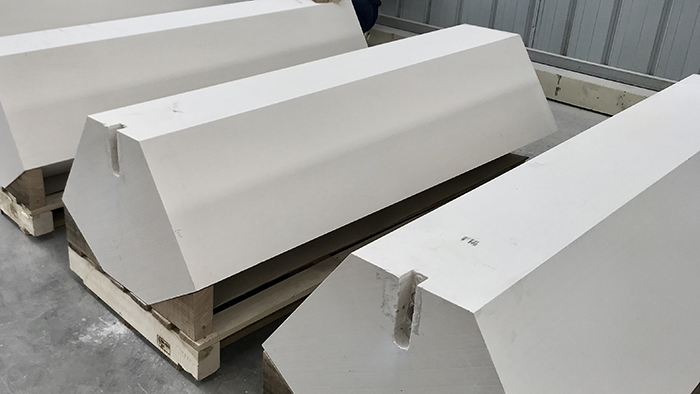
Product List
Success Case
Contact Us
- 0086 371 63838939
- 0086 371 63835539
- sales@sunriserefr.com
- tkfanyi
- No.36 Fengchan Road, Zhengzhou City

News
Analysis of the Causes of the Erosion of Fused Zirconium Corundum during Use
- More related products
- Fused Cast AZS Block
- Fused Cast Alumina Block
- Fused Cast High Zirconia Block
- Fused Cast Skid Rail Block
The chemical action on fused corundum bricks is more complicated and severe, and can be divided into 4 aspects:

(1) Precipitation of glass phase
Pool wall fused zirconium alumina bricks have been exposed to high temperature glass liquid (21500 ° C) for a long time. On the one hand, the glass phase in the brick will gradually melt and precipitate (minimum precipitation temperature is about 1150 ° C). On the other hand, alkaline glass liquid containing Na20 will The pores and cracks in the brick penetrate into the brick and diffuse and interpenetrate with the precipitated glass phase, thus reducing the viscosity of the precipitated liquid glass and improving the fluidity, thereby intensifying the erosion behavior and expanding in depth.
(2) The skeleton is damaged
With the deepening of the glass liquid erosion in depth, the framework minerals that make up the brick body are gradually infiltrated and surrounded by the glass liquid containing Na20, and the skeleton also begins to be eroded. First, the dissolved mullite is decomposed into a-A1203 and SiO2, and then promotes the conversion of a-A1203 to B-A1203. As the temperature increases, -A1203 is completely dissolved in the glass liquid, and the oblique and corundum lattices Destroyed, then fragmented, disintegrated, and partially melted. B-A1203 gradually dissolves in glass at high temperature and is rarely retained. With the continuous diffusion and penetration of glass, the microcrystals of oblique stones become free. Come down. Although oblique stone can be dissolved in glass, its solubility is very small. With the fluctuation of temperature, Zro2 quickly crystallizes from the glass liquid to form a skeleton-like or beaded oblique stone.
(3) Crystallization of new minerals
As the skeleton mineral part of the brick body flame is melted in the glass liquid, the composition of the original glass liquid is changed. Therefore, when the ratio of SiO2-A1203-Na20 in the glass liquid is close to the theoretical composition of nepheline, a large number of nepheline crystals are precipitated.
(4) Damage of Xia Shi
Because the density of nepheline is smaller than the density of the brick body, while the most of the nepheline is precipitated, the structure of the brick body is loosened with the expansion of a large volume. Although the melting of a part of the crystalline phase in the brick at this time will increase the viscosity of the glass liquid and have a certain bonding and protection effect on the loose structure, it still cannot completely block the airflow material in the kiln and the effect of the glass liquid scouring and gravity, and crack and peel It enters the glass liquid and forms glass stones. After peeling, the wound surface continued to be washed away by the erosion of glass liquid and continued to peel off. The result will inevitably lead to the erosion and disintegration of fused zircon corundum bricks.
- Read more
- Introduction to the properties of refractory bricks
- Brief introduction of silica-alumina refractory brick
- Sunrise Refractory teaches you how to solve the insufficient bulk density of non-shrinkage fused bricks
- Brief Introduction of Fused Zirconia Corundum Brick
- Performance characteristics and procurement considerations of azs corundum brick
Leave Message
For more information on any of our products please get in touch using the form below. One of our sales team will respond to your enquiry as soon as possible.

Copyright © 2014 Zhengzhou Sunrise Refractory Co., Ltd. Site Index Product Index












